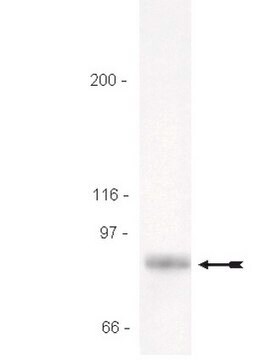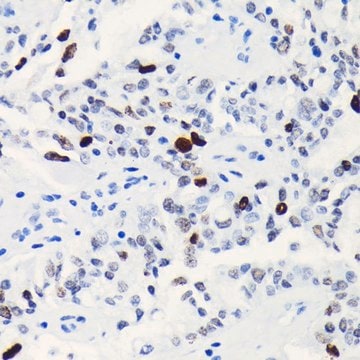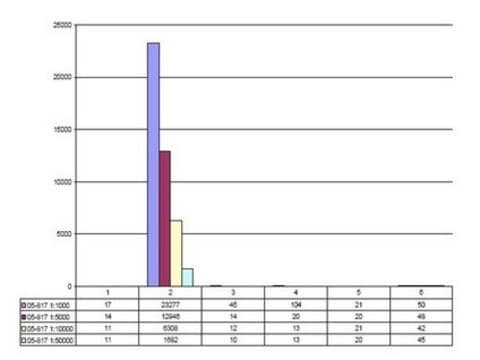17-10269
ChIPAb+ Phospho-Histone H3 (Ser28) Antibody
from rabbit, purified by affinity chromatography
Synonim(y):
Histone H3.1t, H3/t, H3t, H3/g
About This Item
Polecane produkty
pochodzenie biologiczne
rabbit
Poziom jakości
forma przeciwciała
affinity purified immunoglobulin
klon
polyclonal
oczyszczone przez
affinity chromatography
reaktywność gatunkowa
mouse, human
producent / nazwa handlowa
ChIPAb+
Upstate®
metody
ChIP: suitable
dot blot: suitable
immunocytochemistry: suitable
inhibition assay: suitable (peptide)
western blot: suitable
numer dostępu NCBI
numer dostępu UniProt
Warunki transportu
dry ice
Opis ogólny
The ChIPAb+ Phospho-Histone H3 (Ser28) set includes the Phospho-Histone H3 (Ser28) antibody, a Normal Rabbit IgG, and control primers which amplify a 166 bp region of the human GAPDH promoter. The Phospho-Histone H3 (Ser28) and negative controls are supplied in a scalable "per ChIP" reaction size and can be used to functionally validate the precipitation of Phospho-Histone H3 (Ser28)-associated chromatin.
Immunogen
Zastosowanie
Representative lot data.
Sonicated chromatin prepared from untreated or colcemid-treated HeLa cells (1 X 106 cell equivalents per IP) were subjected to chromatin immunoprecipitation using either 5 µl Normal rabbit IgG, or 5 µl Anti-phospho-Histone H3 (Ser28) and the Magna ChIP® A Kit (Cat. # 17-610). Successful immunoprecipitation of phospho-Histone H3 (Ser28)- associated DNA fragments was verified by qPCR using ChIP Primers, human GAPDH promoter region for untreated and treated chromatin samples (Figure 2). Data is presented as percent input of each IP sample relative to input chromatin for each amplicon and ChIP sample as indicated.
Please refer to the EZ-Magna ChIP A (Cat. # 17-408) or EZ-ChIP (Cat. # 17-371) protocol for experimental details.
Western Blot Analysis:
Representative lot data.
HeLa acid extract (lane 1) and recombinant Histone H3 (lane 2) were probed with Anti-phospho-Histone H3 (Ser28) (1:2,000 dilution).
Proteins were visualized using a Donkey Anti-Rabbit IgG secondary antibody conjugated to HRP and a chemiluminescence detection system. (Figure 3)
Arrow indicates phospho-Histone H3 (Ser28) (~17 kDa).
Dot Blot Specificity Analysis:
Representative lot data.
Histone peptides with various modifications (see table) were probed with Anti-phospho-Histone H3 (Ser28). Proteins were visualized using a Donkey Anti-Rabbit IgG secondary antibody conjugated to HRP and a chemiluminescence detection system. (Figure 4)
Immunocytochemistry Analysis
Representative lot data
Confocal fluorescent analysis of HeLa cells using Anti-phospho-Histone H3 (Ser28) (Red). Actin filaments have been labeled with AlexaFluor 488 dye-Phalloidin (Green). Nucleus is stained with DAPI (Blue). This antibody positively stains the mitotic cell nucleus. (Figure 5)
Peptide Inhibition Assay: A 1:500 dilution from a representative lot was blocked by phospho-Histone H3 (Ser28) peptides, but not non-specific peptides.
Epigenetics & Nuclear Function
Histones
Opakowanie
Jakość
Representative lot data.
Sonicated chromatin prepared from colcemid-treated HeLa cells (1 X 106 cell equivalents per IP) were subjected to chromatin immunoprecipitation using either 5 µl Normal rabbit IgG, or 5 µl Anti-phospho-Histone H3 (Ser28) and the Magna ChIP® A Kit (Cat. # 17-610). Successful immunoprecipitation of phospho-Histone H3 (Ser28)-associated DNA fragments was verified by qPCR using ChIP Primers, human GAPDH promoter region (Figure 1).
Please refer to the EZ-Magna ChIP A (Cat. # 17-408) or EZ-ChIP (Cat. # 17-371) protocol for experimental details.
Opis wartości docelowych
Postać fizyczna
Normal Rabbit IgG. Two vials containing 75 μL of normal rabbit IgG in buffer containing 0.01M PBS with 0.1% sodium azide. Store at -20°C.
ChIP Primers, human GAPDH promoter. One vial containing 75 μL of 5 μM each primer specific for human GAPDH. Store at -20°C.
FOR: TAC TAG CGG TTT TAC GGG CG
REV: TCG AAC AGG AGG AGC AGA GAG CGA
Przechowywanie i stabilność
Note: Variability in freezer temperatures below -20°C may cause glycerol containing solutions to become frozen during storage.
Komentarz do analizy
Includes normal rabbit IgG and primers specific for human GAPDH promoter
Informacje prawne
Oświadczenie o zrzeczeniu się odpowiedzialności
Kod klasy składowania
10 - Combustible liquids
Certyfikaty analizy (CoA)
Poszukaj Certyfikaty analizy (CoA), wpisując numer partii/serii produktów. Numery serii i partii można znaleźć na etykiecie produktu po słowach „seria” lub „partia”.
Masz już ten produkt?
Dokumenty związane z niedawno zakupionymi produktami zostały zamieszczone w Bibliotece dokumentów.
Nasz zespół naukowców ma doświadczenie we wszystkich obszarach badań, w tym w naukach przyrodniczych, materiałoznawstwie, syntezie chemicznej, chromatografii, analityce i wielu innych dziedzinach.
Skontaktuj się z zespołem ds. pomocy technicznej








